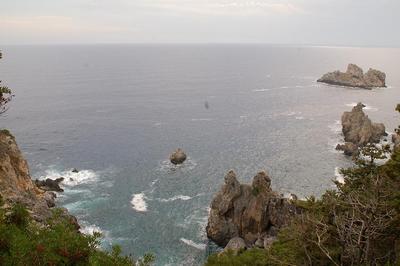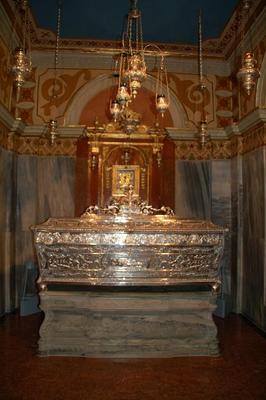September 27, 2005: Corfu (Kerkyra)
 Before heading up to Romania, I made a quick trip to the island of Corfu to pick up some holy things to be delivered to the priest I'm meeting in Romania. Greece has a pretty good and reliable bus, train & plane transportation infrastructure. After a 6:30 hour bus ride and 1:15 hour ferry boat ride, I made it to the northern most island on Greece's west coast. From Corfu one can see its northern neighbor, Albania, and Italy is only a few hours further by ferry boat. Corfu is a very scenic island with contrasting peaks and dramatic cliffs to beautiful beaches with very clear water. The island has a rather dramatic recent history, rivaling that of the rest of Greece, with foreign occupiers ranging from the Venetians (1436-1797), to the French (1797-1805), ending with the English (1805-1864) when the island returned to Greek governance. Because of this, most of the ancient architecture was left intact (because the Venetians respected their rich culture/history & respected St. Spyridon), but you can see primarily the Venetian influence in more recent architecture and definitely in the church art and furnishings. This is something entirely different than the later romantic & western influences in Byzantine iconography (see photo).
Before heading up to Romania, I made a quick trip to the island of Corfu to pick up some holy things to be delivered to the priest I'm meeting in Romania. Greece has a pretty good and reliable bus, train & plane transportation infrastructure. After a 6:30 hour bus ride and 1:15 hour ferry boat ride, I made it to the northern most island on Greece's west coast. From Corfu one can see its northern neighbor, Albania, and Italy is only a few hours further by ferry boat. Corfu is a very scenic island with contrasting peaks and dramatic cliffs to beautiful beaches with very clear water. The island has a rather dramatic recent history, rivaling that of the rest of Greece, with foreign occupiers ranging from the Venetians (1436-1797), to the French (1797-1805), ending with the English (1805-1864) when the island returned to Greek governance. Because of this, most of the ancient architecture was left intact (because the Venetians respected their rich culture/history & respected St. Spyridon), but you can see primarily the Venetian influence in more recent architecture and definitely in the church art and furnishings. This is something entirely different than the later romantic & western influences in Byzantine iconography (see photo).
This island is proud of its unique character, traditions and history, boasting of two ancient fortresses reasonably intact, and two major Orthodox treasures (incorrupt relics of St. Spyridon and Empress Theodora). St. Spyridon is consider the protector of Corfu and his incorrupt relic (see photo
 of reliquary…although I have a nice high res print I need to scan in to send, actually showing his relics) is housed in a church bearing his name. My time in Corfu was spent with a priest who had served at this church for two years. He told me much that he learned from his time serving at St. Spyridon's, such as the story about his shoes wearing out every year by his feast day due to him going & doing good works was a pious myth (he explained that they had to change them out annually due to them wearing out from the volume of visitors and veneration), the fact that his relic stayed at normal body temperature year round and retains its elasticity and pliability, and that the flesh was normal skin color except for the parts exposed to centuries of candle smoke (he reposed in the 4 th century and was translated to Corfu from Constantinople in 1456). I also was surprised to discover that the relic of Empress Theodora (the Empress who reinstated the veneration of icons in 843, which we celebrate on the Sunday of Orthodoxy in Great Lent) is also incorrupt from the 9 th century (see photo…and you'll have to wait for photos from the relics to be scanned in for her relics too). They also process (a reverent parade) with her relics at least once a year, while they process through the city with St. Spyridon's three days during the year. I venerated at several of the small local church, but unfortunately most didn't allow photos. The last church of note was dedicated to St. Eleftherios, which kept many of its relics out for pilgrims to venerate: George the Great Martyr, Panteleimon, Eleftherios, Paraskevi, Haralampos, Prokopios, John Kalyvides, Merkurios, James the Persian, Nilos the Myrrh-streamer, Barbara the Great, and Ermolaos.
of reliquary…although I have a nice high res print I need to scan in to send, actually showing his relics) is housed in a church bearing his name. My time in Corfu was spent with a priest who had served at this church for two years. He told me much that he learned from his time serving at St. Spyridon's, such as the story about his shoes wearing out every year by his feast day due to him going & doing good works was a pious myth (he explained that they had to change them out annually due to them wearing out from the volume of visitors and veneration), the fact that his relic stayed at normal body temperature year round and retains its elasticity and pliability, and that the flesh was normal skin color except for the parts exposed to centuries of candle smoke (he reposed in the 4 th century and was translated to Corfu from Constantinople in 1456). I also was surprised to discover that the relic of Empress Theodora (the Empress who reinstated the veneration of icons in 843, which we celebrate on the Sunday of Orthodoxy in Great Lent) is also incorrupt from the 9 th century (see photo…and you'll have to wait for photos from the relics to be scanned in for her relics too). They also process (a reverent parade) with her relics at least once a year, while they process through the city with St. Spyridon's three days during the year. I venerated at several of the small local church, but unfortunately most didn't allow photos. The last church of note was dedicated to St. Eleftherios, which kept many of its relics out for pilgrims to venerate: George the Great Martyr, Panteleimon, Eleftherios, Paraskevi, Haralampos, Prokopios, John Kalyvides, Merkurios, James the Persian, Nilos the Myrrh-streamer, Barbara the Great, and Ermolaos. 
My hosts were wonderful and I was overwhelmed by traditional Greek and Romanian hospitality…which was good to get me prepared for my trip to Romania (and I thought I'd lose weight on this trip!). The priest took me sight seeing around the country side, to his local parish (which could be considered a museum in its own right), and see some of the beautiful churches and monasteries (see photo of countryside). My visit was short, too short, but I hope to make it back later when I try to pilgrimage through Greece more thoroughly…and maybe actually attend one of the processions of St. Spyridon!
Labels: Greece


1 Comments:
Nice write-up. Corfu is not the Northernmost island in the Ionian. North of Corfu are the Paxoi and Atnipaxoi. Thanks for the mention of Saint Theodora. She is so often overlooked but was brought to Corfu by the same priest/family that brought Saint Spyridon from Constantinople.
Post a Comment
<< Home